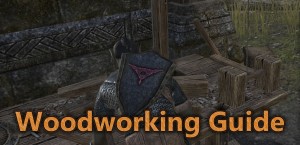 Woodworking is one of the three professions in The Elder Scrolls Online which create equippable items. Blacksmiths create metal weapons and Heavy armor, Clothiers make Light and Medium armor, while Woodworkers are able to craft Bows, Staves and Shields.
Woodworking is one of the three professions in The Elder Scrolls Online which create equippable items. Blacksmiths create metal weapons and Heavy armor, Clothiers make Light and Medium armor, while Woodworkers are able to craft Bows, Staves and Shields.
While woodworking is somewhat less popular than most other tradeskills, it’s by no means without benefits. Archers looking to create their own bows or mages wanting unique staves will certainly find this craft skill useful to specialize in. The following guide will give you a basic overview of Woodworking.
Contents:
Basics
Woodworking is used to create staff weapons, shields and bows. Particularly useful for archers, ranged casters, healers and even tanks, woodworking can be beneficial at all stages of the game. Materials used are of course various types of wood, and to start your woodworking adventures you don’t need to invest any skill points. Crafting items past level 14 though will require you to start spending skill points in the passive skill line, which has further benefits as well.
Woodworkers can also add and research traits, and improve and deconstruct items. Various aspects of this profession are further explained below.
Materials
As soon as you finish Coldharbour tutorial and come to your starting island, you’ll start coming across Maple Wood, the first wood type used to craft the basic items. It’s used to craft level 1-14 equipment and doesn’t require any skill points invested to be used, but must be refined into Sanded Maple before it can be used to craft items. All raw materials used by woodworkers are listed in the table below:
| Material | Level |
|---|---|
| Maple | 1-14 |
| Oak | 16-24 |
| Beech | 26-34 |
| Hickory | 36-44 |
| Yew | 46-50 |
| Birch | 50 (increased damage and resist 1-3) |
| Ash | 50 (increased damage and resist 4-6) |
| Mahogany | 50 (increased damage and resist 7-8) |
| Nightwood | 50 (increased damage and resist 9-10) |
Refining Raw wood into Sanded wood is done by visiting any woodworking crafting station in the world, and selecting the “Extraction” tab. On average you’ll need about 7 Raw wood to refine into Sanded, but the numbers can vary.
Woodworking Skill Line
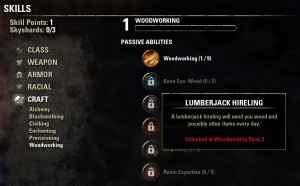 A variety of passive skills is available to woodworkers, some of which are necessary for higher level crafting, while some are just convenient and helpful to pick up. You can invest a total of 24 points into this skill tree, with “Woodworking” having 1 skill point invested by default.
A variety of passive skills is available to woodworkers, some of which are necessary for higher level crafting, while some are just convenient and helpful to pick up. You can invest a total of 24 points into this skill tree, with “Woodworking” having 1 skill point invested by default.
- Woodworking (1/9) – Allows the use of higher level wood.
- Keen Eye: Wood (3) – Wood nodes in the world are easier to spot within 20/30/40 meters.
- Lumberjack Hireling (3) – Lumberjack hireling will send you woodworking materials and possibly other items once or twice a day.
- Wood Extraction (3) – Improves your chances of extracting Woodworking ingredients.
- Carpentry (3) – Reduces research times by 5% and allows researching two/three items at the same time.
- Resin Expertise (3) – Increases your chance to improve items with resins.
If your goal is (and it should be) to craft highest level items, investing 8 points into Woodworking will be necessary, otherwise you won’t be able to use ingredients past Maple Wood. Keen Eye: Wood can easily be skipped, especially if you have no trouble seeing raw materials in the world. Wood is often much easier to spot than herbs or cloth nodes so feel free to skip Keen Eye. Lumberjack Hireling is a matter of preference, but if you can afford 3 points I suggest taking it: extra raw materials and resins are always helpful.
Wood Extraction will also help you get more materials and save gold in the long run. Since you’ll be extracting most of the items you create, it can be wise to pick Wood Extraction up as soon as you can. Carpentry is very important and I highly suggest spending 3 skill points in it: research times take tremendous amount of time and decreasing it by 20% can mean a huge difference. Additionally, being able to research up to three traits concurrently is also a big time saver. Lastly Resin Expertise will help you spend less resources to improve your items, especially important since higher quality resins are hard to come by, and fairly expensive.
Research
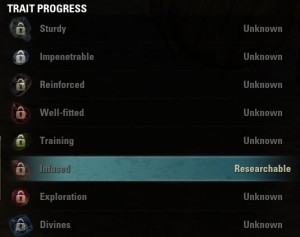 Blacksmithing and Clothing have a total of 112 traits to research, while Woodworking has “only” 48. Regardless, it does take over 6 months of real time to research all traits on all items craftable with this profession. Therefore, it’s not as necessary to invest skill points to reduce research times, but it still can be quite helpful if you wish to be able to craft a variety of items as soon as possible.
Blacksmithing and Clothing have a total of 112 traits to research, while Woodworking has “only” 48. Regardless, it does take over 6 months of real time to research all traits on all items craftable with this profession. Therefore, it’s not as necessary to invest skill points to reduce research times, but it still can be quite helpful if you wish to be able to craft a variety of items as soon as possible.
Armor and weapon traits works the same for woodworkers as it does for tailors and blacksmiths. To research a particular trait you will need to destroy an existing item with the same trait. The first research will take 6 hours, and once a trait is researched you can add it only to the same item type when crafting. Essentially it means if you research Precise (increased critical strike rating) trait on a bow, you will not be able to add the trait to any item except another bow, unless you research it for other item slots as well. Researching the same trait for additional items however doubles the time required to research it.
I have a much more detailed explanation about learning traits here so make sure you read it if you need more information about it.
Extraction
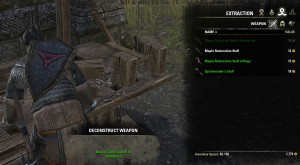 Extraction is used to break down existing items into their base materials, and will destroy them permanently. By deconstructing equipment you can gain wood used to construct the items, but also resins, racial style gems ingredients and Inspiration. You can extract any items, including quest rewards, monster drops, and even items crafted by you or other players.
Extraction is used to break down existing items into their base materials, and will destroy them permanently. By deconstructing equipment you can gain wood used to construct the items, but also resins, racial style gems ingredients and Inspiration. You can extract any items, including quest rewards, monster drops, and even items crafted by you or other players.
Deconstructing items created by other players give you almost three times as much Inspiration points (IP) than deconstructing your own items, so if possible always try to trade your crafted items with other players. Extraction is the most important part of leveling your Woodworking profession, so instead of selling items to vendors for measly amounts of gold it’s definitely more worth it to extract them for ingredients and inspiration.
Improvement
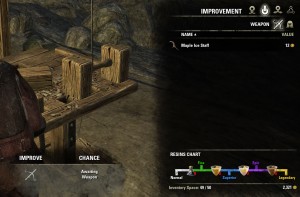 Much like Clothing and Blacksmithing, Woodworkers can also improve the quality of items. Improving increases the bonuses you get from your equipment, including base defenses, traits and enchants. There are five item quality levels: white (normal), green (fine), blue (superior), purple (epic) and gold (legenday). To upgrade the item quality you will need Resins, which are obtained by deconstructing items, via your Miner Hireling passive, or by purchasing them from other players.
Much like Clothing and Blacksmithing, Woodworkers can also improve the quality of items. Improving increases the bonuses you get from your equipment, including base defenses, traits and enchants. There are five item quality levels: white (normal), green (fine), blue (superior), purple (epic) and gold (legenday). To upgrade the item quality you will need Resins, which are obtained by deconstructing items, via your Miner Hireling passive, or by purchasing them from other players.

Resins include Pitch (upgrading white items to green), Turpen (green to blue), Mastic (blue to purple) and Rosin (purple to yellow). Adding just one resin will have a 20% chance to improve an item, and if you fail the improvement process the original item will be permanently destroyed. You can add 5 resins to have a guaranteed chance of improvement, or you can invest skill points into Resin Expertise in the Woodworking skill line for increased base chance to improve item’s quality.
Racial Styles
 Woodworkers can also craft in different racial styles. Your own race’s style is automatically unlocked, but other 13 racial motifs will need to be learned via skill books found throughout Tamriel. You can start finding racial motif books even in starting zones, or alternatively purchase them from other players.
Woodworkers can also craft in different racial styles. Your own race’s style is automatically unlocked, but other 13 racial motifs will need to be learned via skill books found throughout Tamriel. You can start finding racial motif books even in starting zones, or alternatively purchase them from other players.
Once you consume a skill book with a racial style it will be unlocked for all professions, not just Woodworking. Racial motifs don’t affect item’s bonuses or attributes, only its visual appearance.
Leveling
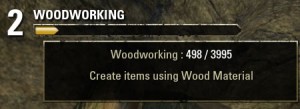 Creating items is intended to provide you with equipment, and isn’t the most optimal way to level up a profession, though it is a significant portion of your IP gains. Experience in tradeskills is indicated with Inspiration, and crafting and deconstructing items both provides you with Inspiration points (IP). You can also find lore books throughout the world which when used give you one level in Woodworking, additionally helping you level it up quicker.
Creating items is intended to provide you with equipment, and isn’t the most optimal way to level up a profession, though it is a significant portion of your IP gains. Experience in tradeskills is indicated with Inspiration, and crafting and deconstructing items both provides you with Inspiration points (IP). You can also find lore books throughout the world which when used give you one level in Woodworking, additionally helping you level it up quicker.
The biggest contribution to IP gain is deconstruction, just like other creation trade skills. Higher level and better quality items will give you more IP than extracting lower level or lower quality items, of course. Additionally you can extract raw materials from items you crafted yourself thus recycling some of the materials you spent, but it’s ill advised: extracting identical items crafted by other players (or your alt characters) will give you around 800% more IP. Ask your friends or guild mates to exchange their crafted items with yours, and both of you will benefit greatly from it.
IP yield is not tied to the amount of materials used to craft items, but by the level of the items, so whenever possible try to craft items which don’t take a lot of raw materials to be crafted. Typically those are level 4 and level 14 items, but I’ll post specific and more detailed calculations on IP gains shortly right here so stay tuned.
Closing
While often overlooked, Woodworking can be just as useful as other professions. If you want to supply your guild with quality bows, shields and staves Woodworking is a worthwhile investment of time and gold, and due to research times it’s best to consider leveling it as early as possible. For solo play however this profession is not as useful as some others since the combination of shields, staves and bows is far too uncommon for any build.
For a basic overview of all professions and other aspects and tricks regarding tradeskills be sure to see my crafting guide: it will give you a general insight into all professions, and includes links to more detailed guides for specific crafts.
Lastly you can consider reading Killerguides Strategy Guide, a professional ESO strategy guide giving you comprehensive insight into crafting secrets as well as nearly every other aspect of the game.

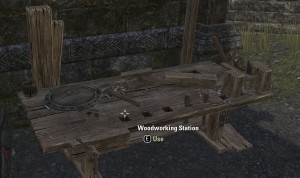

I’ve done some calculation :
Xp / Mats
(not counting race mat)
lvl Daggers Wood Cloth
Iron Maple Jute/RawHide
1 24.00 11.80
4 31.66 19.17
6 31.75 21.71
8 29.80 17.70
10 25.57
12 25.38
14
Steel Oak Flax/Hide
16 86.00 119.25 50.17
18 72.75 105.40 48.43
20 65.20 96.50 47.25
22 58.50 87.29 44.89
24 56.43 84.63 45.40
Orichalcum Beech Cotton/Leather
26 150.20 56.67
28 132.67 54.70
30 120.43 53.18
32 112.00 52.33
34 101.67 52.00
The table in my previous post didn’t carry properly 🙁
There was nothing under maple or under Orichalum.
Basically you alway get the most xp per mats on the smallest piece you can make, dagger, belt. for wood they are all the same.
Then, for first tier mats lvl 6 is the best all across
and for the following tiers the lowest level for that mat. is the one that pays the most.
Hope this helps.
Have fun.
I’m trying to get a grasp on the table, but your comment explained it better. Thanks, very helpful.